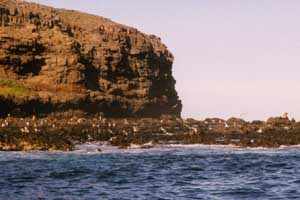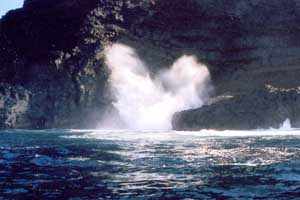We moored for about an hour in the small bay via which the monitoring teams land and ascend the steep cliffs. Here we could observe vast numbers of Fur Seals at rest and play – some climbing the rocks to surprising heights.
Just some of the birds seen during the morning included Pacific and Kelp Gulls, Pied Cormorants and Terns, and not least, an Australian Kestrel perched high on a cliff-top above the bay in which we were moored.
Philip Rayment
The highlight for us was the time that we were stopped in a cove. and were able to watch the seals. The young pups (born in December, we were told) were frolicking in shallow pools – what you could call nurseries. Pracising their swimming, rolling over and over, not venturing into the deep water at all.
There were 8-12 Dolphins in one pool, close to Port Fairy.
Raptors on the cliffs of the island included a pair of Kestrels, Brown Falcon, Australian Hobby.
Norma and Peter Garlick.
We had never seen the island up close like this and we were impressed by how complex its geography and structure really was – all those little reefs, shelfs, caves, cliffs, rock-scree slopes, blowholes, sheltered bays and mostly heavily populated with seals.
We also saw several raptor species, most notably at least two pair of Peregrine Falcons. Coming from Victoria’s dry interior we were impressed by the Black-faced Shags, Gannets, Silver Gulls, Pacific Gulls and the dolphins which swam close to the boat on both the trip out and closer to Port Fairy on the return voyage.
The seals performed for us while we were tied up in the sheltered bay where it is barely possible to imagine anyone landing. Noboby had a tape recorder but we’re convinced that they sounded like a flock of lambs calling for help continuously.
Jana and Rod Orr, Bendigo FNC.
As we moored alongside the landing site on the island the waves washed the kelp up, spreading it out. On droppiong, the jelp clung in long smooth tendrils along the rocks. The seals would, on occasion, use these as slides, dropping down into the sea with apparent pleasure to continue playing in the rising and falling waves.
From the back of the boat we looked down into the sea. It was clear with weeds covering the floor. Large fish, up to 50cm, of various species could be seen, and once a larger Gunny Shark, well over a metre, swam under the boat. The seals which were seen were obviously in there element with quite extraordinary flexibility, twisting and turning in the water.
Altogether, with the schools of dolphin, gannets, terns at sea, peregrines hunting along the tops of the cliffs under a clear blue sky, this was a perfect morning. Our boatman was excellent.
Jane Cleary


1. Seals and kelp on the rock platform.
2. Blow hole at Lady Julia Percy Island
Photos: Denis Hurley.